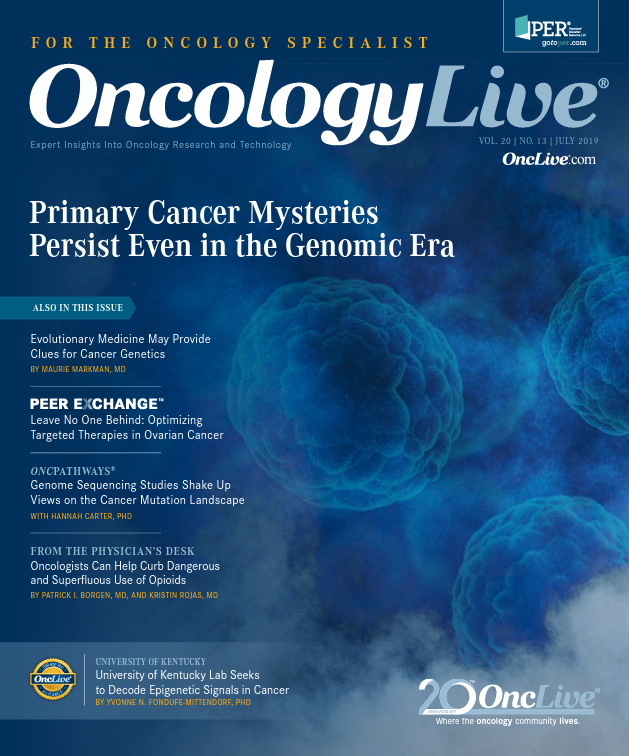Evolutionary Medicine May Provide Clues for Cancer Genetics
Today, with the routine performance of single gene or germline panel testing, as well as a critical focus on prospective follow-up of individuals with incompletely understood germline variants, clinicians are developing an increasingly robust appreciation for the influence of an individual’s genetic background on the likelihood of developing specific malignancies or a group of malignant conditions.

Maurie Markman, MD
Long before the explosion of molecular data about germline abnormalities or variants that can increase the lifetime risk for developing a malignancy, physicians were taught the importance of obtaining a detailed family history from their patients to learn about the potential for a genetic risk. Classic examples of the value of such knowledge include the development of epithelial ovarian cancer or early onset breast cancer in several generations or the documentation of colon cancer in members of a family at a young age.
Today, with the routine performance of single gene or germline panel testing, as well as a critical focus on prospective follow-up of individuals with incompletely understood germline variants, clinicians are developing an increasingly robust appreciation for the influence of an individual’s genetic background on the likelihood of developing specific malignancies or a group of malignant conditions.
In the case of the BRCA genes, the relevance of this knowledge has extended beyond individual risk projections into evidence-based recommendations for strategies to favorably affect that risk (eg, prophylactic oophorectomy, mastectomy) or to increase cancer-related surveillance. More recently, the presence of BRCA mutations in women with ovarian or breast cancer has led to the use of targeted therapeutic agents (PARP inhibitors) to influence mechanisms of the molecular abnormalities. Knowledge of the relevance of germline events that influence the risk of future cancer for an individual or family member, or that may be exploited to achieve a successful therapeutic outcome, has led to an increase in basic and translational laboratory investigations as well as clinical trials. Research teams are actively exploring mechanisms of resistance to PARP inhibitors, such as the functional reversion of a BRCA-mutant state to a wild-type state and the combination of this class of drugs with other antineoplastic strategies, such as checkpoint inhibitors.
Persistence of Genetic Aberrations
One area of investigation that has, to date, received less attention within the general medical or oncology literature is the perplexing question of why certain genetic aberrations (eg, BRCA1 and BRCA2) that may substantially increase the risk of a fatal malignancy have persisted to such an extent within the human population.
The results of one detailed prospective analysis of a large United States health program revealed that approximately 0.5% of individuals in an unselected population—that is, independent of ethnic background or prior cancer history—possessed a BRCA1 or BRCA2 molecular abnormality.1 These data suggest that 1 of every 200 individuals will have a germline mutation in these genes that may increase their risk of several potential malignancies. In certain well-defined groups, such as the Ashkenazi Jewish population, the likelihood for discovering the presence of these harmful molecular events may be considerably greater.
A relatively new and evolving area of medicine seeks to address such questions. Evolutionary medicine examines human health from the perspective of our closest distant ancestors and seeks to learn how this information may be employed to favorably influence approaches to both individual health and public health policy.
One provocative theory within this arena is the idea that specific genetic variants or mutations may have a favorable impact on reproductive success while having a measurably negative effect in individuals as they age and beyond their reproductive years.2 Experimental models have supported the potential relevance of this concept, which is known as antagonistic pleiotrophy.2
In theory, examples of this phenomenon might include the positive evolutionary selection of genetic variants that favor rapid and extensive bone deposition of calcium in children and adolescents. This might subsequently enhance their survival prospects in a hostile natural environment but might also result in greater tissue calcium deposition in arteries later in life, leading to coronary or cerebral vascular disease.
In the cancer arena, one can propose that the favorable impact of genetic variants associated with higher testosterone levels leads to more successful mating outcomes among individuals possessing this genetic trait. However, as with the previous calcium example, this characteristic could also result in a greater risk for the development of prostate cancer later in life.
Returning to the BRCA mutation question, investigators have provided provocative data suggesting there is a favorable impact on reproductive success in women with these molecular abnormalities compared with females with germline wild-type BRCA. Employing data from the Utah Population Database, which includes multigenerational pedigrees, and linking this information to individuals with BRCA1 or BRCA2 mutations, the investigators found that women born before 1930 had more children, less time between each child, and ended the reproductive phase of their lives later than individuals who did not possess this molecular abnormality.3 Further, and as would likely have been anticipated due to the subsequent availability of effective birth control, differences between mutation carriers and women without BRCA mutations born after 1930 persisted but were reduced. Finally, as would have been expected, earlier postreproductive era death associated with the presence of a BRCA mutation was confirmed within this large population database.3
It is important to acknowledge that a single study, especially one that relies exclusively on a retrospective analysis of a population in which it is difficult to control for multiple alternative factors (eg, socioeconomic status, religious, ethnic traditions) that may influence the reported outcomes, cannot be considered definitive proof. However, these results, including the documented shorter postreproductive survival, are rational and may help to explain the continued strong persistence of these cancer-related genes into the 21st century.
References
- Manickam K, Buchanan AH, Schwartz MLB, et al. Exome sequencing-based screening for BRCA1/2 expected pathogenic variants among adult biobank participants. JAMA Netw Open. 2018;1(5):e182140. doi: 10.1001/jamanetworkopen.2018.2140.
- Austad SN, Hoffman JM. Is antagonistic pleiotrophy ubiquitous in aging biology? Evol Med Public Health. 2018;2018(1): 287-294. doi: 10.1093/emph/eoy033.
- Smith KR, Hanson HA, Mineau G, Buys SS. Effects of BRCA1 and BRCA2 mutations on female fertility. Proc Biol Sci. 2012;279(1732):1389-1395. doi: 10.1098/rspb.2011.1697.




